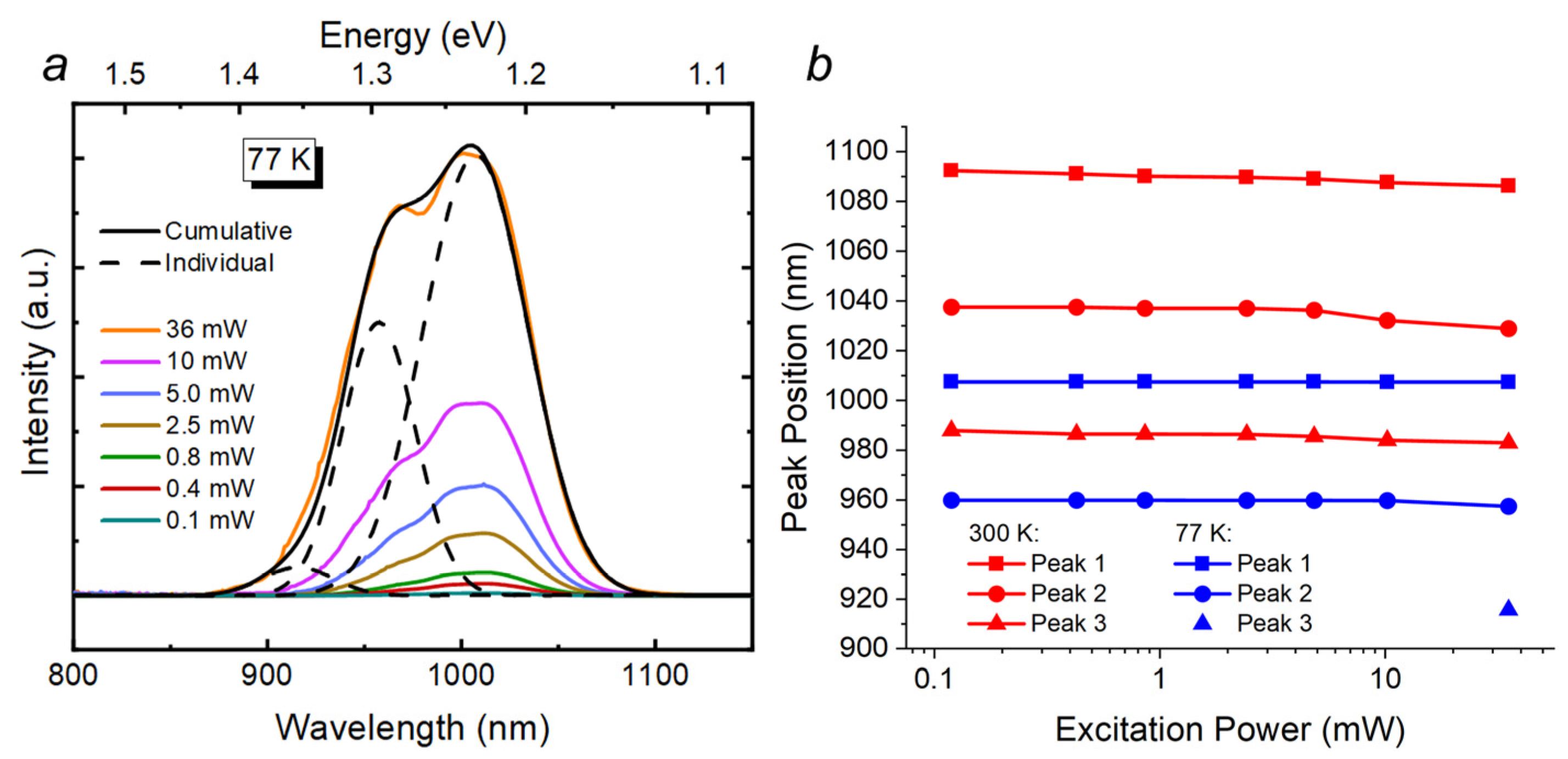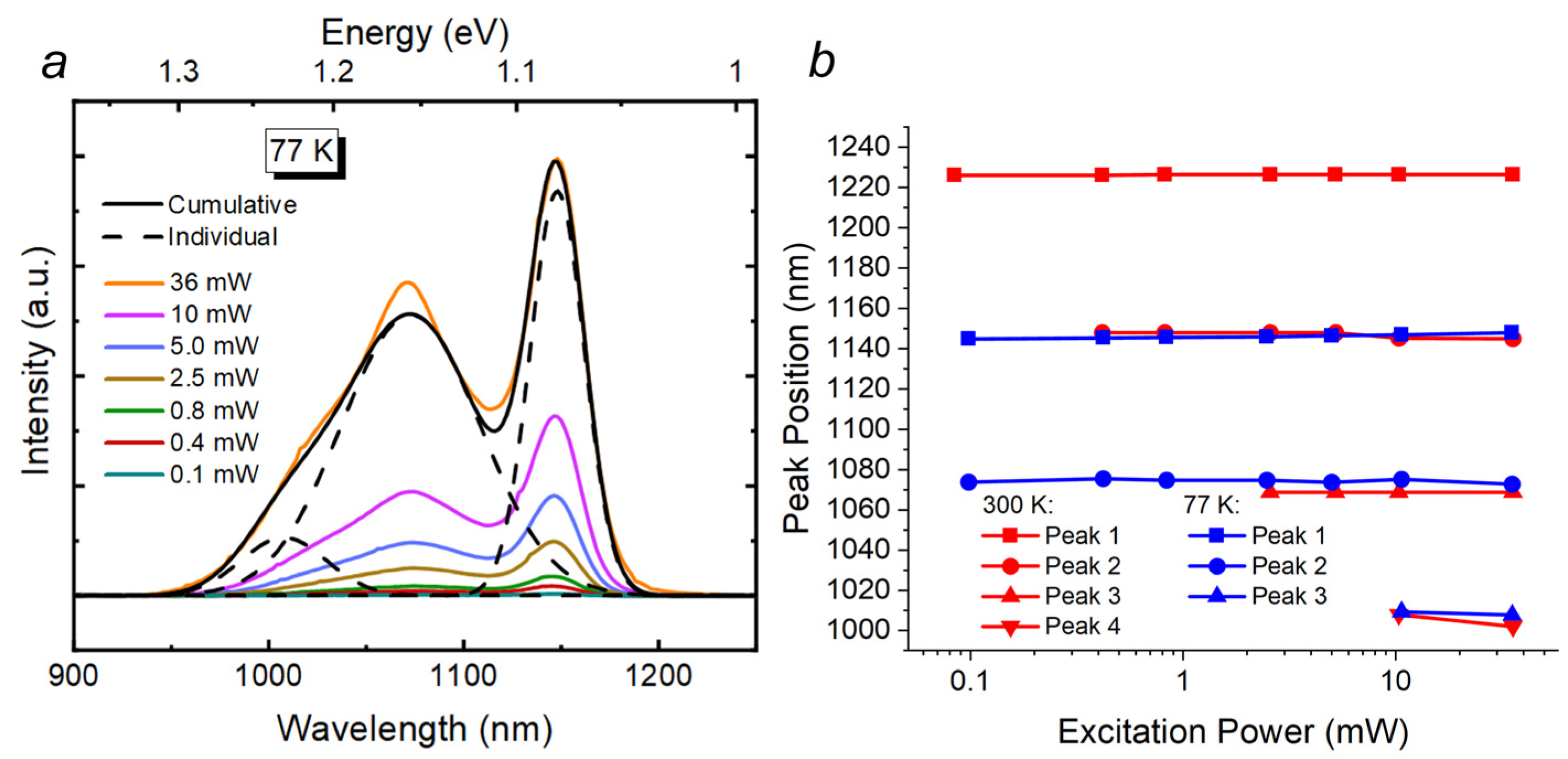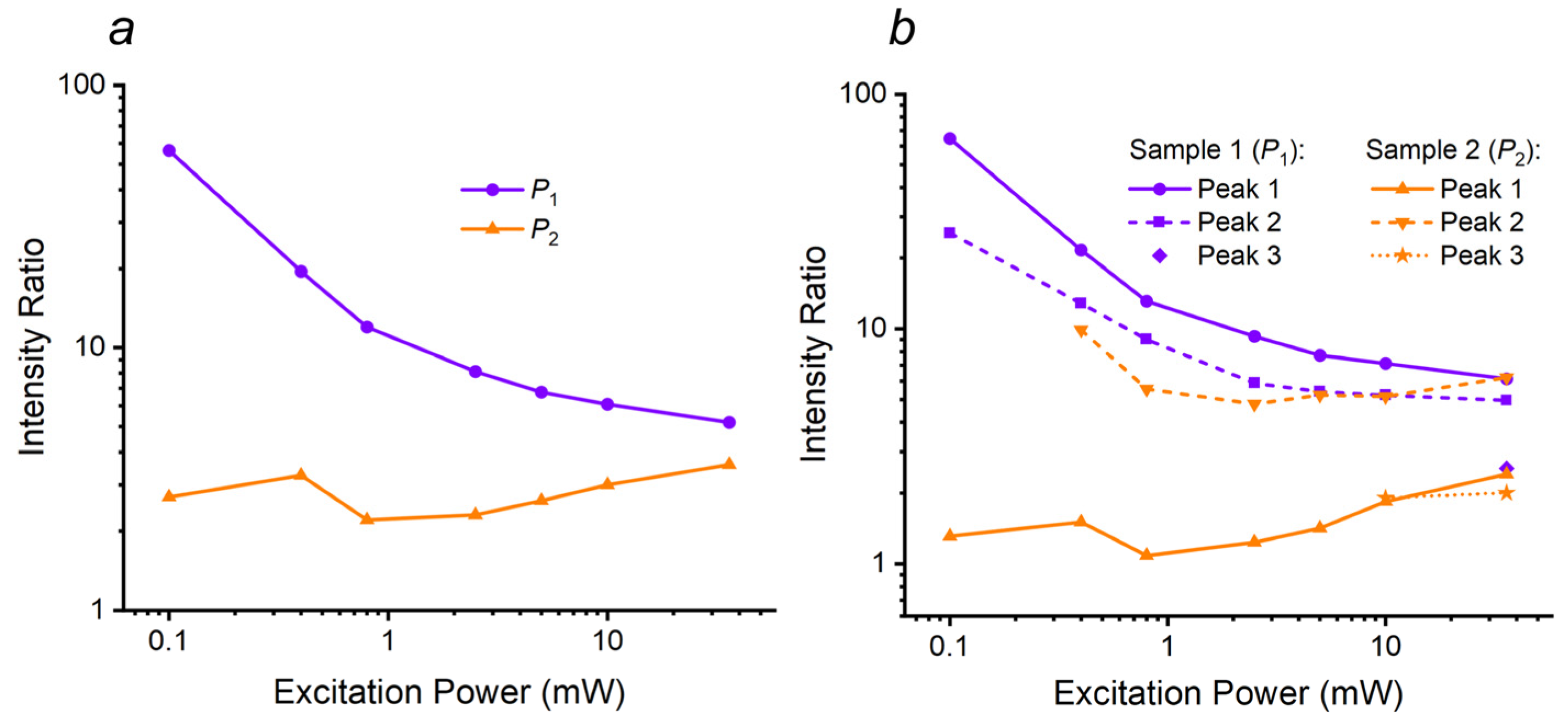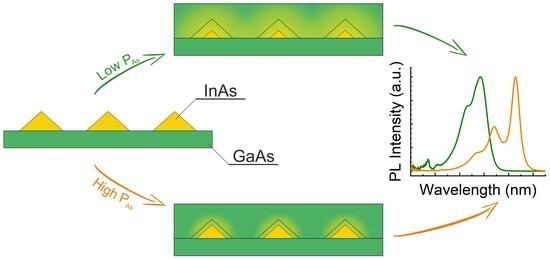Influence of the Arsenic Pressure during Rapid Overgrowth of InAs/GaAs Quantum Dots on Their Photoluminescence Properties
Abstract
:1. Introduction
2. Materials and Methods
3. Results
4. Discussion
5. Conclusions
Author Contributions
Funding
Data Availability Statement
Conflicts of Interest
References
- Pryor, C. Geometry and Material Parameter Dependence of InAs/GaAs Quantum Dot Electronic Structure. Phys. Rev. B 1999, 60, 2869–2874. [Google Scholar] [CrossRef]
- Johansen, J.; Stobbe, S.; Nikolaev, I.S.; Lund-Hansen, T.; Kristensen, P.T.; Hvam, J.M.; Vos, W.L.; Lodahl, P. Size Dependence of the Wavefunction of Self-Assembled InAs Quantum Dots from Time-Resolved Optical Measurements. Phys. Rev. B-Condens. Matter Mater. Phys. 2008, 77, 073303. [Google Scholar] [CrossRef]
- Li, S.Y.; He, L. Recent Progresses of Quantum Confinement in Graphene Quantum Dots. Front. Phys. 2022, 17, 33201. [Google Scholar] [CrossRef]
- Bimberg, D.; Ledentsov, N. Quantum Dots: Lasers and Amplifiers. J. Phys. Condens. Matter 2003, 15, R1063–R1076. [Google Scholar] [CrossRef]
- Ledentsov, N.N.; Kovsh, A.R.; Zhukov, A.E.; Maleev, N.A.; Mikhrin, S.S.; Vasil’ev, A.P.; Semenova, E.S.; Maximov, M.V.; Shernyakov, Y.M.; Kryzhanovskaya, N.V.; et al. High Performance Quantum Dot Lasers on GaAs Substrates Operating in 1.5 µm Range. Electron. Lett. 2003, 39, 1126. [Google Scholar] [CrossRef]
- Zhao, T.M.; Chen, Y.; Yu, Y.; Li, Q.; Davanco, M.; Liu, J. Advanced Technologies for Quantum Photonic Devices Based on Epitaxial Quantum Dots. Adv. Quantum Technol. 2020, 3, 1900034. [Google Scholar] [CrossRef]
- García de Arquer, F.P.; Talapin, D.V.; Klimov, V.I.; Arakawa, Y.; Bayer, M.; Sargent, E.H. Semiconductor Quantum Dots: Technological Progress and Future Challenges. Science 2021, 373, eaaz8541. [Google Scholar] [CrossRef]
- Costantini, G.; Rastelli, A.; Manzano, C.; Acosta-Diaz, P.; Songmuang, R.; Katsaros, G.; Schmidt, O.G.; Kern, K. Interplay between Thermodynamics and Kinetics in the Capping of InAs/GaAs(001) Quantum Dots. Phys. Rev. Lett. 2006, 96, 226106. [Google Scholar] [CrossRef]
- García, J.M.; Medeiros-Ribeiro, G.; Schmidt, K.; Ngo, T.; Feng, J.L.; Lorke, A.; Kotthaus, J.; Petroff, P.M. Intermixing and Shape Changes during the Formation of InAs Self-Assembled Quantum Dots. Appl. Phys. Lett. 1997, 71, 2014–2016. [Google Scholar] [CrossRef]
- Ferdos, F.; Wang, S.; Wei, Y.; Larsson, A.; Sadeghi, M.; Zhao, Q. Influence of a Thin GaAs Cap Layer on Structural and Optical Properties of InAs Quantum Dots. Appl. Phys. Lett. 2002, 81, 1195–1197. [Google Scholar] [CrossRef]
- Hospodková, A.; Hulicius, E.; Pangrác, J.; Oswald, J.; Vyskočil, J.; Kuldová, K.; Šimeček, T.; Hazdra, P.; Caha, O. InGaAs and GaAsSb Strain Reducing Layers Covering InAs/GaAs Quantum Dots. J. Cryst. Growth 2010, 312, 1383–1387. [Google Scholar] [CrossRef]
- Trevisi, G.; Suárez, I.; Seravalli, L.; Rivas, D.; Frigeri, P.; Muñoz-Matutano, G.; Grillo, V.; Nasi, L.; Martínez-Pastor, J. The Effect of High-In Content Capping Layers on Low-Density Bimodal-Sized InAs Quantum Dots. J. Appl. Phys. 2013, 113, 194306. [Google Scholar] [CrossRef]
- Okumura, S.; Fujisawa, K.; Naruke, T.; Nishi, K.; Onishi, Y.; Takemasa, K.; Sugawara, M.; Sugiyama, M. Impact of Low-Temperature Cover Layer Growth of InAs/GaAs Quantum Dots on Their Optical Properties. Jpn. J. Appl. Phys. 2022, 61, 085503. [Google Scholar] [CrossRef]
- Okumura, S.; Fujisawa, K.; Yamaguchi, M.; Naruke, T.; Nishi, K.; Takemasa, K.; Sugawara, M.; Sugiyama, M. Impact of Dislocations in InAs Quantum Dot with InGaAs Strain-Reducing Layer Structures on Their Optical Properties. Jpn. J. Appl. Phys. 2021, 60, 035507. [Google Scholar] [CrossRef]
- Zhang, Z.Y.; Oehler, A.E.H.; Resan, B.; Kurmulis, S.; Zhou, K.J.; Wang, Q.; Mangold, M.; Süedmeyer, T.; Keller, U.; Weingarten, K.J.; et al. 1.55 Μm InAs/GaAs Quantum Dots and High Repetition Rate Quantum Dot SESAM Mode-Locked Laser. Sci. Rep. 2012, 2, 477. [Google Scholar] [CrossRef]
- Banyoudeh, S.; Reithmaier, J.P. High-Density 1.54 Μm InAs/InGaAlAs/InP(100) Based Quantum Dots with Reduced Size Inhomogeneity. J. Cryst. Growth 2015, 425, 299–302. [Google Scholar] [CrossRef]
- Mikhrin, V.S.; Vasil’ev, A.P.; Semenova, E.S.; Kryzhanovskaya, N.V.; Gladyshev, A.G.; Musikhin, Y.G.; Egorov, A.Y.; Zhukov, A.E.; Ustinov, V.M. InAs/InGaNAs/GaNAs QW and QD Heterostructures Emitting at 1.4–1.8 Μm. Semiconductors 2006, 40, 342–345. [Google Scholar] [CrossRef]
- González, D.; Flores, S.; Ruiz-Marín, N.; Reyes, D.F.; Stanojević, L.; Utrilla, A.D.; Gonzalo, A.; Gallego Carro, A.; Ulloa, J.M.; Ben, T. Evaluation of Different Capping Strategies in the InAs/GaAs QD System: Composition, Size and QD Density Features. Appl. Surf. Sci. 2021, 537, 148062. [Google Scholar] [CrossRef]
- Balakirev, S.; Chernenko, N.; Kryzhanovskaya, N.; Shandyba, N.; Kirichenko, D.; Dragunova, A.; Komarov, S.; Zhukov, A.; Solodovnik, M. Photoluminescence Properties of InAs Quantum Dots Overgrown by a Low-Temperature GaAs Layer under Different Arsenic Pressures. Electronics 2022, 11, 4062. [Google Scholar] [CrossRef]
- Utrilla, A.D.; Grossi, D.F.; Reyes, D.F.; Gonzalo, A.; Braza, V.; Ben, T.; González, D.; Guzman, A.; Hierro, A.; Koenraad, P.M.; et al. Size and Shape Tunability of Self-Assembled InAs/GaAs Nanostructures through the Capping Rate. Appl. Surf. Sci. 2018, 444, 260–266. [Google Scholar] [CrossRef]
- Lian, G.D.; Yuan, J.; Brown, L.M.; Kim, G.H.; Ritchie, D.A. Modification of InAs Quantum Dot Structure by the Growth of the Capping Layer. Appl. Phys. Lett. 1998, 73, 49–51. [Google Scholar] [CrossRef]
- Ulloa, J.M.; Reyes, D.F.; Utrilla, A.D.; Guzman, A.; Hierro, A.; Ben, T.; González, D. Capping Layer Growth Rate and the Optical and Structural Properties of GaAsSbN-Capped InAs/GaAs Quantum Dots. J. Appl. Phys. 2014, 116, 134301. [Google Scholar] [CrossRef]
- Riel, B.; Hinzer, K.; Moisa, S.; Fraser, J.; Finnie, P.; Piercy, P.; Fafard, S.; Wasilewski, Z. InAs/GaAs(100) Self-Assembled Quantum Dots: Arsenic Pressure and Capping Effects. J. Cryst. Growth 2002, 236, 145–154. [Google Scholar] [CrossRef]
- Chu, L.; Arzberger, M.; Böhm, G.; Abstreiter, G. Influence of Growth Conditions on the Photoluminescence of Self-Assembled InAs/GaAs Quantum Dots. J. Appl. Phys. 1999, 85, 2355–2362. [Google Scholar] [CrossRef]
- Yamaguchi, K.; Saito, Y.; Ohtsubo, R. Size-Shrinkage Effect of InAs Quantum Dots during a GaAs Capping Growth. Appl. Surf. Sci. 2002, 190, 212–217. [Google Scholar] [CrossRef]
- Lan, H.; Ding, Y. Ordering, Positioning and Uniformity of Quantum Dot Arrays. Nano Today 2012, 7, 94–123. [Google Scholar] [CrossRef]
- Takehana, K.; Pulizzi, F.; Patanè, A.; Henini, M.; Main, P.C.; Eaves, L.; Granados, D.; Garcia, J.M. Controlling the Shape of InAs Self-Assembled Quantum Dots by Thin GaAs Capping Layers. J. Cryst. Growth 2003, 251, 155–160. [Google Scholar] [CrossRef]
- Patella, F.; Fanfoni, M.; Arciprete, F.; Nufris, S.; Placidi, E.; Balzarotti, A. Kinetic Aspects of the Morphology of Self-Assembled InAs Quantum Dots on GaAs(001). Appl. Phys. Lett. 2001, 78, 320–322. [Google Scholar] [CrossRef]
- Wang, H.; Ning, D.; Feng, S. Temperature Dependence of the Optical Properties of InAs/GaAs Self-Organized Quantum Dots with Bimodal Size Distribution. J. Cryst. Growth 2000, 209, 630–636. [Google Scholar] [CrossRef]
- Ruiz-Marín, N.; Reyes, D.F.; Stanojević, L.; Ben, T.; Braza, V.; Gallego-Carro, A.; Bárcena-González, G.; Ulloa, J.M.; González, D. Effect of the AlAs Capping Layer Thickness on the Structure of InAs/GaAs QD. Appl. Surf. Sci. 2022, 573, 151572. [Google Scholar] [CrossRef]
- Kiravittaya, S.; Nakamura, Y.; Schmidt, O. Photoluminescence Linewidth Narrowing of InAs/GaAs Self-Assembled Quantum Dots. Phys. E Low-Dimens. Syst. Nanostructures 2002, 13, 224–228. [Google Scholar] [CrossRef]
- Rosenauer, A.; Gerthsen, D.; Van Dyck, D.; Arzberger, M.; Böhm, G.; Abstreiter, G. Quantification of Segregation and Mass Transport in InxGa1−xAs/GaAs Stranski-Krastanow Layers. Phys. Rev. B 2001, 64, 245334. [Google Scholar] [CrossRef]
- Gong, Q.; Offermans, P.; Nötzel, R.; Koenraad, P.M.; Wolter, J.H. Capping Process of InAs/GaAs Quantum Dots Studied by Cross-Sectional Scanning Tunneling Microscopy. Appl. Phys. Lett. 2004, 85, 5697–5699. [Google Scholar] [CrossRef]
- Eisele, H.; Lenz, A.; Heitz, R.; Timm, R.; Dähne, M.; Temko, Y.; Suzuki, T.; Jacobi, K. Change of InAs/GaAs Quantum Dot Shape and Composition during Capping. J. Appl. Phys. 2008, 104, 124301. [Google Scholar] [CrossRef]
- Miserev, D.S.; Sushkov, O.P. Dimensional Reduction of the Luttinger Hamiltonian and G-Factors of Holes in Symmetric Two-Dimensional Semiconductor Heterostructures. Phys. Rev. B 2017, 95, 085431. [Google Scholar] [CrossRef]





Disclaimer/Publisher’s Note: The statements, opinions and data contained in all publications are solely those of the individual author(s) and contributor(s) and not of MDPI and/or the editor(s). MDPI and/or the editor(s) disclaim responsibility for any injury to people or property resulting from any ideas, methods, instructions or products referred to in the content. |
© 2023 by the authors. Licensee MDPI, Basel, Switzerland. This article is an open access article distributed under the terms and conditions of the Creative Commons Attribution (CC BY) license (https://creativecommons.org/licenses/by/4.0/).
Share and Cite
Balakirev, S.; Kirichenko, D.; Chernenko, N.; Shandyba, N.; Komarov, S.; Dragunova, A.; Kryzhanovskaya, N.; Zhukov, A.; Solodovnik, M. Influence of the Arsenic Pressure during Rapid Overgrowth of InAs/GaAs Quantum Dots on Their Photoluminescence Properties. Crystals 2023, 13, 1358. https://doi.org/10.3390/cryst13091358
Balakirev S, Kirichenko D, Chernenko N, Shandyba N, Komarov S, Dragunova A, Kryzhanovskaya N, Zhukov A, Solodovnik M. Influence of the Arsenic Pressure during Rapid Overgrowth of InAs/GaAs Quantum Dots on Their Photoluminescence Properties. Crystals. 2023; 13(9):1358. https://doi.org/10.3390/cryst13091358
Chicago/Turabian StyleBalakirev, Sergey, Danil Kirichenko, Natalia Chernenko, Nikita Shandyba, Sergey Komarov, Anna Dragunova, Natalia Kryzhanovskaya, Alexey Zhukov, and Maxim Solodovnik. 2023. "Influence of the Arsenic Pressure during Rapid Overgrowth of InAs/GaAs Quantum Dots on Their Photoluminescence Properties" Crystals 13, no. 9: 1358. https://doi.org/10.3390/cryst13091358





